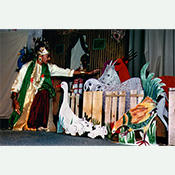 The tirthankaras teach that all living beings possess a soul (jiva), each caught up in a nearly endless cycle of rebirth. The ultimate goal of Jainism is to free the soul from this cycle of rebirth, to attain moksha (liberation).
The tirthankaras teach that all living beings possess a soul (jiva), each caught up in a nearly endless cycle of rebirth. The ultimate goal of Jainism is to free the soul from this cycle of rebirth, to attain moksha (liberation).
The tirthankaras taught that all living beings, from humans to blades of grass, possess souls, or jivas, literally “life” or “life-force.” The “sacred” in all life is not understood as an undifferentiated, all-pervasive spirit. Rather, there is an infinite multitude of individual and precious souls. Each soul, each jiva, is caught up in an ongoing cycle of life, shedding the body time and again, like yesterday’s clothes. The ultimate goal of life is to leave this cycle of rebirth behind through the liberation of the soul from all that obscures its true, perfect nature.
A liberated soul, called a siddha, does not possess a body. Rather it transcends the cycle of life and death and dwells in moksha, literally, freedom, having regained its original state of pure energy. Jains often say that if one were to speak of “God” in the Jain tradition, it would be as the perfected soul. But the relation of the siddha to the world is not that of an active guide or decision maker, but of an unending source of luminous energy. Since each soul in its purest form is a siddha, the practice of Jainism can be described as finding “God” within.
As Jains see it, all beings are animated by jiva, the soul. A modern-day Jain teacher, Gurudev Chitrabhanu, writes, “The universe is not for humanity alone; it is a field of evolution for all living beings. Life is sacred, irrespective of not only caste, color, creed, or nationality, but also species at all levels right down to the tiny ant or the humble worm.”
There are souls in nonmobile bodies, such as earth, water, fire, air, and plants—all of which have but one sense, the sense of touch. And there are souls in mobile bodies: the worm with two senses (touch and taste), the ant with three (touch, taste, and smell), the bee with four (touch, taste, smell, and sight), and the animal and human with five (touch, taste, smell, sight, and hearing).